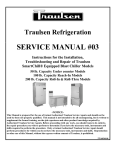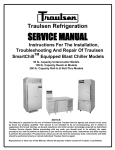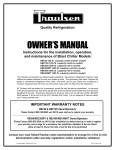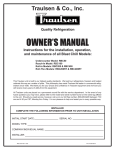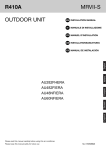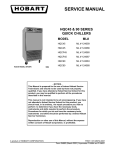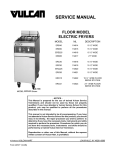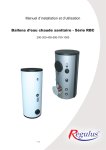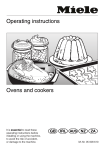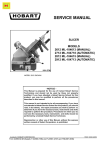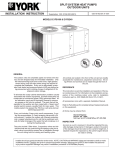Download Traulsen RBC100 Blast Chiller Reach In Unit
Transcript
Traulsen Refrigeration SERVICE MANUAL #02 Instructions For The Installation, Troubleshooting And Repair Of Traulsen SmartChillTM Equipped Blast Chiller Models 50 lb. Capacity Undercounter Models 100 lb. Capacity Reach-In Models 200 lb. Capacity Roll-In & Roll-Thru Models -NOTICEThis Manual is prepared for the use of trained Authorized Traulsen Service Agents and should not be used by those not properly qualified, nor should the equipment for which it is prepared be adjusted or repaired by anyone except properly qualified personnel. This manual is not intended to be all encompassing, but is written to supplement the formal training, on-the-job experience and other product knowledge acquired by Authorized Traulsen Service Agents. Reproduction or other use of this Manual, without the express written consent of Traulsen & Co., Inc. is prohibited. FORM NUMBER TR????? - REV. 6/03 TABLE OF CONTENTS I. THE SERIAL TAG 1 II. GENERAL INFORMATION a-Introduction b-Operation c-Cleaning d-Applicable Models e-Wiring Diagrams f-Tool Requirements 2 2 2 2 2 2 III. SPECIFICATIONS/OPERATING DATA 3 V. SmartChillTM FACTORY SETTINGS (cont’d) k-Settings-Defrost INTVL l-Settings-Security Code m-Secure Settings-MACH. MODEL n-Secure Settings-Machine Size o-Secure Settings-Soft Freeze p-Secure Settings-Freeze Max q-Secure Settings-FRZ Min r-Secure Settings-Defrost Type s-Secure Settings-Saving Changes t-Software Version 8 8 9 9 9 9 9 9 9-10 10 VI. CONTROLLER SERVICE PROCEDURES IV. SERVICING THE SMART CHILLTM CONTROL a-Service Mode b-Updating The Service Date c-Setting The Clock d-Service Menu e-Service Menu-Diagnostic Test f-Service Menu-Refrigeration System/Air Flow Test g-Service Menu-Probes/Alarms Test h-Service Menu-Display Test i-Service Menu-Door Test j-Service Menu-Defrost System & Coil Probe Test k-Service Menu-Fan Output Test l-Service Menu-Printer Test 4 4 4 4 4-5 5 5 5-6 6 6 6 6 V. SmartChillTM FACTORY SETTINGS a-Factory Settings Mode b-Resetting The Serial Number c-Settings-Back Door d-Settings-Label Printer e-Settings-Fans In HLD Cycle f-Settings-Blasting DIFF f-Settings-Holding DIFF h-Settings-ANTI-SHORT i-Settings-Defrost Time j-Settings-Defrost Temp 7 7 7 7 7 7 8 8 8 8 a-Controller Board b-I/O Board c-Component Location 11 11 11 VII. COMPONENT FUNCTION 12 VIII. SEQUENCE OF OPERATION a-Refrigeration System b- IDLE Mode c- Hold Mode d-By Time Chill/Freeze Mode e-By Temp Chill/Freeze Mode f-By Product Chill/Freeze Mode g-Defrost Mode` 13 13 13 13 13 14 14 IX. WIRING DIAGRAMS - RBC50 MODELS 15 X. WIRING DIAGRAMS - RBC100 MODELS 16 XI. WIRING DIAGRAMS - RBC200 MODELS 17 XII. TROUBLESHOOTING 18 I. THE SERIAL TAG The serial tag is a permanently affixed sticker on which is recorded vital electrical and refrigeration data about your Traulsen product, as well as the model and serial number. This tag is located on the left side of the interior compartment of all compact undercounter refrigerator, freezer and prep table models. FORT WORTH, TX. SERIAL VOLTS MODEL Hz PH TOTAL CURRENT AMPS MINIMUM CIRCUIT AMPS MAXIMUM OVERCURRENT PROTECTION LIGHTS WATTS HEATERS AMPS AMPS READING THE SERIAL TAG REFRIGERANT DESIGN PRESSURE TYPE HIGH OZ LOW REFRIGERANT DESIGN PRESSURE TYPE HIGH OZ LOW • Serial = The permanent ID# of your Traulsen • Model = The model # of your Traulsen • Volts = Voltage • Hz = Cycle • PH = Phase • Total Current = Maximum amp draw • Minimum Circuit = Minimum circuit required • Lights = Light wattage • Heaters = Heater amperage • Refrigerant = Refrigerant type used • Design Pressure = High & low side operating pressures and refrigerant charge • Agency Labels = Designates agency listings 370-60294-00 REV (A) R R AW-03118 -1- II. GENERAL INFORMATION II. f - TOOL REQUIREMENTS: For most jobs a standard set of hand tools, a VOM with AC current tester, electrically conductive field service grounding kit (p/n TL84919), along with a temperature tester or thermometer are adequate. However in some cases the following additional tools may be required as well: II. a - INTRODUCTION: Blast Chillers are food processing refrigerators designed for rapid chilling of product from 140 F to 40 F in approximately 90 minutes, for reheating and/or serving at a later time. These models aid in preserving food quality, texture and nutritional value, in addition to enhancing food safety. • • • • • • • All of the information, illustrations and specifications contained within this manual are based on the latest product information avaialble at the time of printing. II. b - OPERATION: Refer to the instructions contained in the Owner’s Manual, form number TR35744, for specific operating instructions. II. c - CLEANING: Detailed cleaning instructions are included with each unit, however, special care MUST be given to the condenser coil(s). These must be cleaned WEEKLY. This surface must be kept free of dirt and grease for proper system operation. This can be done with a vacuum cleaner using a brush attachment, or a stiff brush or wisk broom. Care must be taken not to damage the condenser coil fins. For more information please refer to section “IV. a - IV c” of the Blast Chill Owner’s Manual. II. d - APPLICABLE MODELS: This manual applies to the following Traulsen models: RBC50 Undercounter Blast Chiller Models RBC100 Reach-In Blast Chiller Models RBC200 Roll-In Blast Chiller Models RBC200RT Roll-Thru Blast Chiller Models PLEASE NOTE: This manual refers to the above models built after June 2003, equipped with the SmartChillTM control. For information regarding models built prior to that date please contact the factory. In addition, models UBC50, RBC400 and RBC400RT are not covered by the procedures listed in this manual. Please contact the factory for more information. II. e - WIRING DIAGRAMS: Refer to the wiring diagrams on pages ?? thru ?? for any service work performed on the unit. Should you require another copy, please contact Traulsen Service at (800) 825-8220, and provide the model and serial number of the unit involved. -2- Refrigeration Reclaiming Equipment Acetylene Torch Nitrogen Bottle With Gauges Refrigeration Gauge Manifold Dial-a-change Valve Core Removal Kit Vacuum Pump III. SPECIFICATIONS/OPERATING DATA DATA H.P.1 BTU1 H.P.2 BTU2 Refrigerant1 Refrigerant2 Refrigerant Charge1 Refrigerant Charge2 Cond Unit Amp Draw (RLA)1 Cond Unit Amp Draw (RLA)2 Evap Fans Amp Draw (RLA) Unit Voltage Full Load Amps RBC50 1/2 HP 1350 1/2 HP 1350 R-404A R-404A 20 oz. 20 oz. RBC100 1/2 HP 2280 1-1/4 HP 5460 R-404A R-404A 49 oz. 92 oz. RBC200 3/4 HP 3880 n/a3 n/a3 R-404A n/a3 20 oz. n/a3 RBC200RT 3/4 HP 3880 n/a3 n/a3 R-404A n/a3 20 oz. n/a3 115/60/1 18.6 220/115 15.1 115/60/11 115/60/11 15.21 15.21 1= Self-Contained Holding or Primary Compressor. 2= Blast Chilling or Secondary Compressor. 3= These may vary depending upon type of remote condensing unit selected. DIMENSIONS Length - Overall in. Depth - Overall in. Height - Overall in. RBC50 57-1/2 34-1/4 341 RBC100 34 41-5/8 80-1/8 RBC200 48-1/2 37-1/2 89-1/2 RBC200RT 48-1/2 41-1/8 89-1/2 1= Height shown to work top, height over control is 53”. Model: RBC50 Refrigerant R-404A Ambient Temperature 70° F Suction Presure (chill mode) Start of Cycle End of Cycle Suction Presure (freeze mode) Start of Cycle End of Cycle Discharge Pressure PSIG Start of Cycle End of Cycle Model: RBC100 Refrigerant R-404A Ambient Temperature 70° F Suction Presure (chill mode) Start of Cycle End of Cycle Suction Presure (freeze mode) Start of Cycle End of Cycle Discharge Pressure PSIG Start of Cycle End of Cycle Model: RBC200 & RBC200RT Refrigerant R-404A Ambient Temperature 70° F Suction Presure (chill mode) Start of Cycle End of Cycle Suction Presure (freeze mode) Start of Cycle End of Cycle Discharge Pressure PSIG Start of Cycle End of Cycle R-404A 100° F R-404A 100° F -3- R-404A 100° F IV. SERVICING THE SmartChillTM CONTROL IV. a - SERVICE MODE: The SERVICE MODE allows service personnel to exercise the loads and monitor the input of the control independently to deterfmine if the control, the electromechanical components and the refrigeration system are operating properly. WARNING: This procedure requires that the control box be open while the power is supplied to the unit. Exercise extreme caution at all times. CAUTION: Electro-static discharge will damage the control board. Use a anti-static grounding kit when servicing the computer control box. (figure 1) IV. c - SETTING THE CLOCK (cont’d): Pressing the button beside ENTER saves the new date and time selected and displays the last date of service menu. Turn OFF the power to the unit, and remove the control panel screws and swing open the control panel in order to gain access to the service mode switch (see figure 1). Pressing the button beside CANCEL does not save any changes made to the date or time, and returns to the last date of service menu. Locate the service mode switch on the back of the control board, press and hold switch while turning power ON to the chiller. The following menu will be displayed. NOTE: To exit service mode at any time, turn power OFF and back ON to display user main menu. IV. d - SERVICE MENU: Pressing the button beside NEXT when the last date of service menu is displayed prompts the following service menu: LAST DATE OF SERVICE < < < < 00/00/00 < UPDATE < SET CLOCK NOTE: From the service menu, the following servcie modes can be selected: • SERVICE MENU - Diaganostic test • REFRN/AIR - Refrigeration system & air probe test • PROBES/ALARM - View current probes reading and change status of alarm output • DISPLAY - Illuminates entire display • DOORS - Displays status (OPEN or CLOSED) • DEF/COIL - Defrost system & coil probe test • FANS - Tests fan outputs • PRINTERS - Sends test pattern to printer(s) IV. c - SETTING THE CLOCK: Pressing the button beside SET CLOCK in order to display the menu below. ⇓ XX/XX/XX < BACK < CANCEL DOOR > DEF/COIL > FANS > DISPLAY > NEXT > IV. b - UPDATING THE SERVICE DATE: Pressing the button beside UPDATE sets the last date of service to the current date. If date is INVALID, set clock to current date and time. SET CLOCK SERVICE MENU REFR/AIR PROBES/ALARM PRINTER MONTH XX:XX ⇑ NEXT > ENTER > IV. e - SERVICE MENU-DIAGNOSTIC TEST: Pressing the button beside SERVICE MENU prompts the following menu: Pressing the buttons beside BACK or NEXT toggles through selection options: MONTH/DAY/YEAR/HOUR/ MINUTE. < DIAGNOSTIC < RUN CYCLES < SINCE DEF. CYCLES Pressing the buttons beside the UP or DOWN arrows changes the selected date or time numbers. -4- MAXIMUM > MINIMUM > FAILURE > CLEAR > IV. SERVICING THE SmartChillTM CONTROL (cont’d) IV. e - SERVICE MENU-DIAGNOSTIC TEST (cont’d): Pressing the button beside DIAGNOSTIC returns to the service menu. IV. f - SVCE MENU-REF’N SYSTEM/AIR PROBE TEST (cont’d): ON&FANS = Refrigeration and evaporator fans operational. Pressing the button beside RUN CYCLES displays (in the lower left corner of the display) the number of cycles ran since last cleared. The current air temperature inside the cavity is also displayed. The service menu can be accessed by pressing the button beside BACK, and all outputs will return to their OFF state. Pressing the button beside SINCE DEF displays (in the lower left corner of the display) the number of cycles ran since last defrost. Pressing the button beside COMP USAGE displays the days and hours since the last cleaning of the condenser coil. Pressing the button beside MAXIMUM displays (in the lower left corner of the display) the maximum air temperature of the cabinet. NOTE: After cleaning the condenser coil, press the button beside CLEANED COIL to reset the day and hour for both to read “0”. Pressing the button beside MINIMUM displays (in the lower left corner of the display) the minimum air temperature of the cabinet. The previous menu can be accessed by pressing the button beside BACK, and all outputs will return to their OFF state. Pressing the button beside FAILURE displays (in the lower left corner of the display) the failure since last service cleared. If there is more than one failure, pressing the lower elft button will cycle through all the failure. Below is a complete list of all possible failures: IV. g - SERVICE MENU-PROBES/ALARM TEST: From the service menu, pressing the button beside PROBES/ALARM prompts the following menu: DEFR HEAT = Defrost Heater Malfunction. SYSTEM FAIL = Chiller Not Cooling Properly. OVER TEMP = Internal Air Temperature Exceeds 150°F. CONTROL = Control Board Malfunction. INTERRUPTED = A Chilling Cycle Has Been Interrupted Either By Loss Of Main Power Or By Inadvertently Switching Power OFF. PROBE = One Of The Probes Have Malfunctioned: Air, Coil or Product. PRINTER = Printer Not Responding Or Out Of Paper/ Label. This screen displays the value of each product probe. If no value(s) shown find the source of the problem. Pressing the button beside CLEAR clears the current item. The alarm output can also be changed from OFF to ON. IV. f - SERVICE MENU-REF’N SYSTEM & AIR PROBE TEST: From the service menu, pressing the button beside REFN/AIR prompts the following menu: The service menu can be accessed by pressing the button beside BACK, and the alarm output will return to the OFF state. REFRIGERATION TEST: < REFN: OFF AIR TEMP: < COMP USAGE PRODUCT PROBE TEMPS: 1 74°F 2 73°F < ALARM = OFF BACK > IV. h - SERVICE MENU-DISPLAY TEST: From the service menu, pressing the button beside DISPLAY illuminates the entire display (see below). Pressing any key will return the display to the service menu. This option can also be used as a test for the keypad, since any key press will return to the previous menu. 14°F BACK > Pressing the button beside REFN can test the compressor function. The options for REFN are: OFF, ON, and ON&FANS. OFF = ON = 73°F 3 Refrigeration not operational Refrigeration operational -5- IV. SERVICING THE SmartChillTM CONTROL (cont’d) IV. h - SERVICE MENU-DISPLAY TEST (cont’d): NOTE: If the screen does not display as shown above the display board needs to be replaced. If display does not return to the service menu then the keypad needs to be replaced. IV. k - SERVICE MENU-FAN OUTPUT TEST: From the service menu, pressing the button beside FANS displays the fan output test. The options for fans are: NONE, SET 1, SET2 and BOTH. IV. i - SERVICE MENU-DOOR TEST: From the service menu, pressing the button beside DOORS displays the door status (OPEN or CLOSED). FAN MODE TEST: < FAN = NONE FAN DOOR = CLOSED BACK > DOOR INPUTS: NONE = All evaporator fans de-energized. SET 1 = This is the low air flow mode for soft chill mode. Only one evaporator fan is energized. If not find the source of the problem. SET 2 = Two evaporator fans energized. If not find the source of the problem. BOTH = All evaporator fans energized. If not find the source of the problem. OPEN/CLOSED BACK > NOTE: Cycling the door OPEN and CLOSED shows the status of the the unit door(s). If not find the source of the problem. IV. l - SERVICE MENU-PRINTER TEST: From the service menu, pressing the button beside PRINTERS displays the printer test menu - this sends a test print to the printer(s). The service menu can be accessed by pressing the button beside BACK. IV. j - SVCE MENU-DEFROST SYSTEM & COIL PROBE TEST: From the service menu, pressing the button beside DEF/COIL displays the defrost system and coil probe test. DEFROST TEST: < HEATER = OFF COIL TEMP = 76°F PRINTER TEST: < RECORD: READY < LABEL: READY BACK > BACK > NOTE: “LABEL: READY” will not appear on the display if the optional label printer is not included with the particular unit. The defrost heat can be turned OFF or ON by pressing the button beside HEATER. Pressing the button beside RECORD sends a test print out to the standard paper prtinter. The “READY” on the display will change to “RUNNING”, then to “SUCCESS” if the print completes successfully. Otherwise “ERROR” will appear on the display, prompting you to locate the source of the problem. OFF = Defrost heater should not be energized. ON = Defrost heater should energize and coil temperature should slowly increase. The coil temperature is also displayed. If not find the source of the problem. If the optional label printer is installed, the label test print can be run by pressing the button beside LABEL to send out a test print. The service menu can be accessed by pressing the button beside BACK. Doing so also turns the heater OFF. The service menu can be accessed by pressing the button beside BACK. -6- V. SmartChillTM FACTORY SETTINGS V. a - FACTORY SETTINGS MODE: The FACTORY SETTINGS MODE allows service personnel to return various control settings to their factory preset parameters. WARNING: This procedure requires that the control box be open while the power is supplied to the unit. Exercise extreme caution at all times. CAUTION: Electro-static discharge will damage the control board. Use a anti-static grounding kit when servicing the computer control box. (figure 2) Turn OFF the power to the unit, and remove the control panel screws and swing open the control panel in order to gain access to the factory settings mode switch (see figure 2). V. d - SETTINGS-LABEL PRINTER: ⇓ BACK DOOR (NO) ⇓ LABEL PRINTER (NO) ⇓ FAN IN HLD (CYCLE) < RESET Locate the factory settings mode switch on the back of the control board, press and hold switch while turning power ON to the chiller. The following menu will be displayed. NOTE: To exit factory settings mode at any time, turn power OFF and back ON to display user main menu. LABEL PRINTER options are: V. b - RESETTING THE SERIAL NUMBER: To enter the serial number, press the button beside S/N, which changes the digit to edit, and then use the UP arrow to increment the value of the selected digit from 0-9. OFF = No label printer installed. ON = Individual labels. V. e - SETTINGS-FANS IN HLD CYCLE: ⇓ BACK DOOR (NO) ⇓ LABEL PRINTER (NO) ⇓ FAN IN HLD (CYCLE) < RESET FACTORY SETTINGS VERSION: < S/N: < RESET ⇑ ⇑ ⇑ NEXT > NEXT > ⇑ ⇑ ⇑ NEXT > RESET - Resets all the parameters to the factory preset values, and erases all recorded cycles in memory. Fans are defaulted to cycle ON and OFF. Select (CONT) for continuous fan operation during hold mode. Select NEXT to access additional menu options. NEXT - Continues to the next factory settting menu. V. f - SETTINGS-BLASTING DIFF: V. c - SETTINGS-BACK DOOR: BACK DOOR is not an option, select NO. ⇓ BACK DOOR (NO) ⇓ LABEL PRINTER (NO) ⇓ FAN IN HLD (CYCLE) < RESET ⇓ BLASTING DIFF (4) °F ⇓ HOLDING DIFF (4) °F ⇓ ANTI-SHORT (3) < BACK ⇑ ⇑ ⇑ NEXT > ⇑ ⇑ ⇑ NEXT > Blasting differential is the temperature difference between set point temperature and the actual temperature for opening the compressor solenoid when in chill or freeze mode. -7- V. SmartChillTM FACTORY SETTINGS (cont’d) V. g - SETTINGS-HOLDING DIFF: ⇓ BLASTING DIFF (4) °F ⇓ HOLDING DIFF (4) °F ⇓ ANTI-SHORT (3) < BACK V. k - SETTINGS-DEFROST INTVL: ⇓ DEFROST TIME (20) ⇓ DEFR. TEMP (50) °F ⇓ DEFR. INTVL (6) HR < BACK ⇑ ⇑ ⇑ NEXT > Holding differential is the temperature difference for hold mode. ⇑ ⇑ ⇑ NEXT > Defrost interval is the time interval between automatic defrosts. Select NEXT to access additional menu options. V. h - SETTINGS-ANTI-SHORT: V. l - SETTINGS-SECURITY CODE: ⇓ BLASTING DIFF (4) °F ⇓ HOLDING DIFF (4) °F ⇓ ANTI-SHORT (3) < BACK ⇑ ⇑ ⇑ NEXT > ENTER SECURITY CODE FOR NEXT SETTINGS: < (0000000) ⇑ < EXIT ENTER > ANTI-SHORT is the minimum time between closing and opening the compressor solenoid. Select NEXT to access additional menu options. The security code is required in order to access the additional options. The code is the last seven digits of the units serial number reversed. Press the button beside the LEFT arrow to select whch digit to adjust, and then the button beside the UP arrow to increment the value of the selected digit. V. i - SETTINGS-DEFROST TIME: ⇓ DEFROST TIME (20) ⇓ DEFR. TEMP (50) °F ⇓ DEFR. INTVL (6) HR < BACK ⇑ ⇑ ⇑ NEXT > Press button beside ENTER to continue to secured options or press the button beside EXIT to exit the factory settings mode. NOTE: If the incorrect serial number was entered, the below message will appear on the display. DEFROST TIME is the length of defrost time in minutes. INCORRECT CODE! PLEASE CALL TRAULSEN FOR ASSISTANCE NEXT > V. j - SETTINGS-DEFROST TEMP: ⇓ DEFROST TIME (20) ⇓ DEFR. TEMP (50) °F ⇓ DEFR. INTVL (6) HR < BACK ⇑ ⇑ ⇑ NEXT > If the correct code was entered, the below menu will appear on the display, allowing the servicer to proceed on to the secure options. DEFROST TEMP is the set point for the coil temperature. ⇓ MACH. MODEL (RBC) ⇓ MACHINE SIZE (50) ⇓ SOFT CHILL (NO) < BACK -8- ⇑ ⇑ ⇑ NEXT > V. SmartChillTM FACTORY SETTINGS (cont’d) V. q - SECURE SETTINGS-SFT FRZ MIN: V. m - SECURE SETTINGS-MACH.MODEL: ⇓ MACH. MODEL (RBC) ⇓ MACHINE SIZE (50) ⇓ SOFT FREEZE (NO) < BACK ⇓ FREEZE MAX (20) °F ⇓ SFT FRZ MIN (-5) °F ⇓ DEFROST TYPE (ELE) < BACK ⇑ ⇑ ⇑ NEXT > ⇑ ⇑ ⇑ NEXT > SFT FRZ MIN is the minimum selectable value for SOFT CHILL mode for all chiller models. MACH. MODEL is not an option, select NO. V. n - SECURE SETTINGS-MACHINE SIZE: V. r - SECURE SETTINGS-DEFROST TYPE: ⇓ MACH. MODEL (RBC) ⇓ MACHINE SIZE (50) ⇓ SOFT FREEZE (NO) < BACK ⇑ ⇑ ⇑ NEXT > ⇓ FREEZE MAX (20) °F ⇓ SFT FRZ MIN (-5) °F ⇓ DEFROST TYPE (ELE) < BACK MACHINE SIZE is the distinction, in capacity, between the different model/size blast chillers, either 50, 100 or 200. Do not select any other size than actual chiller size. ⇑ ⇑ ⇑ NEXT > DEFROST TYPE is selection for chiller to defrost by (GAS) on RBC50 models and (ELE) for all other models. Press the button beside NEXT to exit factory settings. V. o - SECURE SETTINGS-SOFT FREEZE: V. s - SECURE SETTINGS-SAVING CHANGES: ⇓ MACH. MODEL (RBC) ⇓ MACHINE SIZE (50) ⇓ SOFT FREEZE (NO) < BACK ⇑ ⇑ ⇑ NEXT > FACTORY SETTINGS DO YOU WISH TO SAVE THESE NEW SETTINGS? < NO SOFT FREEZE is not an option, select NO. Select NEXT to access additional menu options. YES > Upon selecting NEXT, the above menu should be displayed. V. p - SECURE SETTINGS-FREEZE MAX: ⇓ FREEZE MAX (20) °F ⇓ SFT FRZ MIN (-5) °F ⇓ DEFROST TYPE (ELE) < BACK YES - Saves the new settings to memory. NO - Exits Factory Settings without saving changes. ⇑ ⇑ ⇑ NEXT > Upon selecting YES (save changes) the below message will appear on the display. SAVING SETTINGS FREEZE MAX is the maximum selectable value for freezing in FREEZE CHILL mode for all chiller models. PLEASE WAIT... -9- V. SmartChillTM FACTORY SETTINGS (cont’d) V. s - SECURE SETTINGS-SAVING CHANGES (cont’d): When the new settings have been saved the below message will be displayed. FACTORY SETTINGS SETUP IS COMPLETE! RESTART CONTROLLER V. t - SOFTWARE VERSION: The control program software version is diaplyed during initialization whenever the unit is turned ON. The display will show the chiller model number and the current software version number as shown below. SMART CHILL RBC50 INITIALIZING VERSION: X.XX -10- VI. CONTROLLER SERVICE PROCEDURES VI. a - CONTROLLER BOARD: The controller has two LED’s to assist in troubleshooting. LED (D2 POWER) is illuminated indicating that power is supplied to the controller board. LED (D1) flashes indicating that the I/O board and control board are communicating. If not, check all harness connections to the communications cables going between the I/O and controller boards. LED (D13) is not used. VI. c - COMPONENT LOCATION: POWER STRIP OVERTEMP THERMOSTAT I/O BOARD EVAPORATOR FANS CAPACITORS (3) VI. b - I/O BOARD: The I/O board has a series of LED’s and test points to assist in troubleshooting. When the LED is illuminated, the component should be energized or input open. TRANSFORMER POWER SUPPLY BOARDS (2) PRINTERS CONTROLLER LED D1 D2 D3 D4 D8 D9 D10 D11 TEST POINT TP1 TP2 TP3 J17, J18 J15, J16 COMPONENT Front Door Not Used Fan Door Compressor Solenoid Defrost Heater Low Fan High Fan Alarm COMPONENT VOLTAGE POWER SWITCH SAFETY THERMOSTAT BULB DEFROST HEATER FAN DOOR SWITCH COIL-TEMP SENSOR EVAPORATOR FAN MOTOR (3) AIR-TEMP SENSOR +12VDC +5VDC 0V 0.75 - 2VAC Voltage Drop 0.75 - 2VAC Voltage Drop EXPANSION VALVE DEFROST HEATER DEFROST HEATER EXPANSION VALVE BULB DUAL PRESSURE SWITCH THERMAL OVERLOAD RUN CAPACITOR RELAY Relays Logic Circuit Ground Triac Compressor Solenoid Triac Defrost Heater POWER SWITCH START CAPACITOR COMPRESSOR CONDENSER FAN MOTOR FRONT VIEW SOLENOID VALVE SIGHT GLASS FILTER DRIER BACK VIEW -11- HOT GAS CONDENSATE EVAPORATOR VII. COMPONENT FUNCTION Compressor Condenser Fan Dual Pressure Control Start Capacitor Run Capacitor Thermal Overload Relay Evaporator Fan Defrost Heater Air Temperature Sensor Coil Temperature Sensor Food Temperature Probe Front Door Switch Fan Door Switch Solenoid Valve Door Perimeter Heater Door Heater Thermostat Controller Power Supply Boards I/O Board Main Contactor Main Switch Over Temp. Thermostat (manual reset) Safety Thermostat (manual reset) Pumps refrigerant through refrigeration lines and components. Draws air across condenser coil to aid in removing heat from the refrigerant and moves air across compressor to aid in cooling the compressor. Low side monitors suction pressure at compressor. Shuts compressor OFF when low pressure setting is reached (cut-out). Allows compressor to run when pres sure rises to cut-in setting. High side monitors discharge pressure at compressor. Shuts compressor OFF when high side pressure setting is reached (cut-out). Allows compressor to run when pressure returns to cut-in setting. The differential is the difference in pressure between open and closed states of the pressure switch. Wired in series with the start windings to help start compressor motor. Continually in circuit to help compressor motor during operation. Removes power from compressor if the internal temperature of the compressor becomes too high (auto reset). Senses current of run winding of compressor motor. Normally open contacts close when run winding draws a high amperage at start and brings the start capacitor and start windings into the circuit. As the motor reaches operating speed (less amperage through run winding), the normally open contacts open and removes the start capacitor and start windings from the circuit. Draws air from the cabinetand moves air through the evaporator coil. Air should blow toward the door. Defrosts evaporator coil and prevents water droplets from evaporator coil from freezing before they can drain to the condensate pan. Operates only during defrost cycle. Monitors air temperature inside the cabinet. Monitors the scution line temperature at evaporator during defrost cycle. Monitors temperature of food product. Monitors door for open or closed position. Evaporator fans stop when door is open. Monitors evaporator fan compartment door for open or closed position. Evaporator fans will not start if the switch is open. Refrigerant system operation stops after 30 seconds switch has been open. Normally closed. When energized, allows refrigerant to flow to flow from receiver to evaporator coil. Prevents condensate on door frame. Monitors door frame temperature. Opens circuit to door frame heater if the door frame temperature exceeds set point. Performs the following functions: a) Displays all data for the current mode of operation. b) Cycles refrigeration system to maintain cabinet temperature. c) Monitors power failures. d) Monitors door position. Controls power to I/O board and printers. Performs the following functions: a) Cycles defrost heaters during defrost cycle. b) Cycles compressor solenoid to maintain cabinet temperature. c) Monitors AC monitor to determine loss of power. d) Closes alarm contact to signal external alarm device, after a malfunction detected. e) Monitors door switch position. f) Monitors fan door switch. Controls power to unitelectrical circuits once main switch is closed. Controls power to main contactor when safety thermostat is closed. Removes power from all components including the controller. Monitors cabinet air temperature. Opens circuit to main contactor if cabinet temperature exceeds 155°F. Monitors cabinet air temperature. Opens circuit to main contactor if cabinet temperature exceeds 155°F. -12- VIII. SEQUENCE OF OPERATION VIII. a - REFRIGERATION SYSTEM: 1. The controller must be in a chill or hold mode. 2. The controller monitors the air temperature and senses a need for cooling. a) The relay that controls the solenoid valve is energized. 1-Solenoid valve is energized and refrigerant flows to the evaporator. 3. The low pressure switch closes with the rise in pressure. a) The compressor motor is energized and refrigerant is pumped through the system. 4. The expansion valve monitors the evaporator superheat and meters the amount of refrigerant entering the evaporator. 5. The controller senses the air temperature requirements have been met. a) De-energizes the relay that controls the solenoid valve. 1-Solenoid valve is de-energized and closes. Refrigerant flow to the evaporator stops. 6. Compressor continues to run. Low pressure control opens as pressure drops. a) Compressor motor de-energized. 7. Unit is cycled by controller. VIII. c - HOLD MODE (cont’d): factory setup menus. NOTE: If the cabinet door is opened during operation, the evaporator fans and refrigeration system will shut down. b) The hold mode has an automatic defrost cycle after a programable interval of operation in the hold mode. 1-When the defrost cycle is complete and the unit returns to the hold mode, the evaporator fans will not operate until the coil temperature is below 25°F. 3. Hold mode is terminated by pressing the exit key. NOTE: If the HOLD MODE is terminated by the operator with the deforst cycle in progress, the defrost mode will continue until completion before going into idle mode. VIII. d - BY TIME CHILL OR FREEZE MODE: 1. Unit is in IDLE mode. 2. Chill type is selected and a cycle time is entered then start key is pressed. 3. The refrigeration system will cycle on the blasting air temperature set-point. a) ON at the set-point plus differentia. b) OFF when set-point is reached. 4. If SOFT CHILL has been selected, the refrigeration system will cycle on the new blasting air temperature set-point. If CHILL was selected, the set-point remians the same until the end of the cycle. NOTE: If the cabinet door is opened during operation, the evaporator fans and refrigeration system will shut down. 5. Chill mode is terminated when time expires. a) Buzzer sounds until muted. 6. At the end of a chill cycle the unit will enter the hold mode. a) If the end of the chill cycle is acknowledged by pressing the STOP/RESET key, the unit will enter the idle mode. VIII. b - IDLE MODE: 1. Conditions a) Unit connected to correct voltage. b) Safety thermostat closed. c) Fan door switch closed. d) Front door switch closed. 2. Main switch closed. a) Main contactor energized, contacts close. 1-Door heater energized. 2-Controller energized. 3-Power to condensing unit controls. 3. Controller goes through power up selfdiagnostics and displays main menu. VIII. c - HOLD MODE: Product can be held at chilled temperature by selecting hold mode from main menu. Unit will also go into hold mode automatically when all active probes have reached the target temperature when in “BY TEMP” mode. If a “BY TIME” mode is slected, the unit enters hold mode automatically after the time has expired. 1. Unit is in IDLE mode. 2. Hold mode is selected. NOTE: When the hold mode is selected, two timers run. One tracks the time in the hold mode and the other tracks the time since the last defrost (hold mode defrosts at a programable interval). a) The refrigeration system will cycle on the air temperature of the cabinet. 1-ON at the set-point plus differential. 2-OFF when set-point reached. NOTE: Set-point and differential are selected in the VIII. e - BY TEMP CHILL OR FREEZE MODE: 1. Unit is in IDLE mode. 2. Chill type is selected and a target teperature is entered then start key pressed and probe selected. 3. The refrigeration system will cycle on the blasting air temperature set-point. NOTE: If the cabinet door is opened during BY TEMP chill operation, the evaporator fans and refrigeration system will shut down. 4. Chill mode is terminated when all the product probes reach the target chill temperature. NOTE: Once the temperature of the probe reaches the target temperature the display will alternate with “DONE”, and the buzzer will sound unless muted. a) At the end of the chill cycle the unit will enter idle mode. -13- VIII. SEQUENCE OF OPERATION (cont’d) VIII. f - BY PRODUCT CHILL OR FREEZE MODE: 1. Unit is in IDLE mode. 2. Product type is selected. 3. Chill type is selected and a target teperature is entered then start key pressed and probe selected. 4. The refrigeration system will cycle on the blasting air temperature set-point. NOTE: If the cabinet door is opened during operation, the evaporator fans and refrigeration system will shut down. 5. Chill mode is terminated when all the product probes reach the target chill temperature. NOTE: Once the temperature of the probe reaches the target temperature the display will alternate with “DONE”, and the buzzer will sound unless muted. a) At the end of the chill cycle the unit will enter idle mode. VIII. g - DEFROST MODE: 1. The defrost mode can be entered manually from the idle mode or automatically from the hold mode. 2. Defrost cycle length is by set minutes or until the coil temperature reaches set-point. NOTE: Minutes and coil temperature are adjustable in the Factory Settings mode. a) If the defrost mode was entered from the hold mode, the unit will return to the hold mode. -14- IX. WIRING DIAGRAM - RBC50 MODELS -15- X. WIRING DIAGRAM - RBC100 MODELS -16- XI. WIRING DIAGRAM - RBC200 MODELS -17- XII. TROUBLESHOOTING WARNING: CERTAIN PROCEDURES IN THIS SECTION REQUIRE ELECTRICAL AND REFRIGERATION SYSTEM TEST OR MEASUREMENTS WHILE POWER IS APPLIED TO THE MACHINE. EXERCISE EXTREME CAUTION AT ALL TIMES. IF TEST POINTS ARE NOT EASILY ACCESSIBLE, DISCONNECT POWER, ATTACH TEST EQUIPMENT AND REAPPLY POWER TO TEST. -18- Traulsen 4401 Blue Mound Road Fort Worth, TX 76106 Phone: (800) 825-8220 Fax-Svce: (817) 740-6757 Website: www.traulsen.com Quality Refrigeration HOURS OF OPERATION: Monday thru Friday 7:30 am - 4:30 pm CST




















